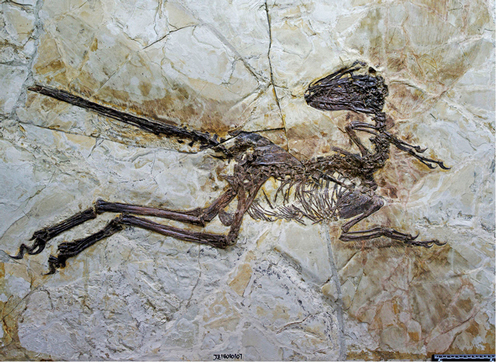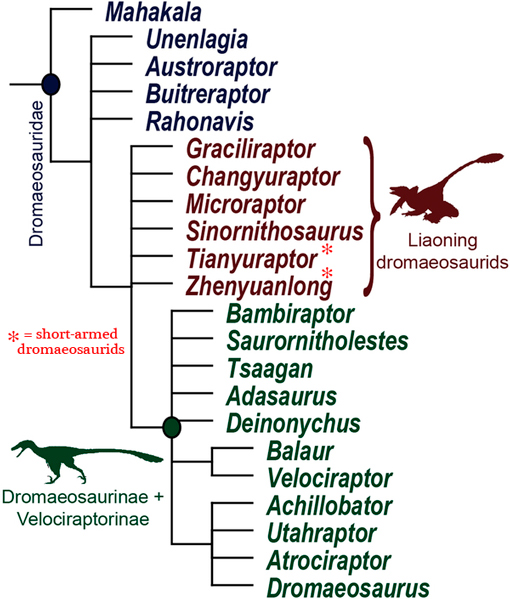The New Winged Dragon from Liaoning Province
Zhenyuanlong – A Big Bird, well, Almost
This week we have seen the latest feathered and fluffy dinosaur revealed from the Lower Cretaceous deposits of Liaoning Province, north-eastern China. Scientists from the University of Edinburgh including the very talented Dr Steve Brusatte, in collaboration with colleagues from the Institute of Geology (Chinese Academy of Geological Science, Beijing), have published a paper in the journal “Scientific Reports”, that describes Zhenyuanlong suni, the latest in an ever growing flock of feathered dinosaurs from Liaoning.
An Illustration of Zhenyuanlong suni
Picture credit: Zhao Chuang
A New Winged Dragon
We do understand why many of the media reports have focused on this Early Cretaceous dinosaur’s more famous relative – Velociraptor. Dr Steve Brusatte of Edinburgh University’s School of GeoSciences refers to Velociraptor in interviews, although, Velociraptor and Zhenyuanlong (pronounced jen-won-long), are separated by some forty-five million years. As Zhenyuanlong suni has been classified as member of the Dromaeosauridae family, it is indeed distantly related to the more famous Late Cretaceous “raptor”. By discussing Velociraptor, it helps members of the public to put this new dinosaur into context.
Zhenyuanlong suni
Zhenyuanlong is most certainly not Velociraptor’s direct ancestor, but if these dinosaurs were feathered, then the point that Velociraptor, shown as a scaly-skinned reptile in dinosaur movies, is in all likelihood not being accurately depicted, is well made. Although no evidence of feathers or any other integumental covering for that matter has been found in association with Velociraptor fossil material. This has probably got more to do with the fossilisation process and the coarse sandstone matrix than any lack of feathers on Velociraptor’s part.
Velociraptor – Most Probably Feathered
Picture credit: Everything Dinosaur
Dromaeosaurid Models
The picture above shows the new for 2015, Velociraptor dinosaur model by Safari Ltd. The model depicts Velociraptor as a dinosaur that was covered in a coat of feathers. To view Everything Dinosaur’s range of Safari Ltd prehistoric animal models, including feathered dinosaur models: Feathered Dinosaur Models – Wild Safari Prehistoric World.
The Liaoning Dromaeosaurids – Now There are Six Genera
A total of six genera of dromaeosaurids are now known to have lived in the forests that once covered north-eastern China. Several of these genera have more than one species associated with them and there are going to be more feathered dinosaurs described from the Yixian and Jiufotang Formations. Everything Dinosaur team members will do their best to keep up to date with new discoveries and to write about them on this blog.
The six genera described to date:
- Sinornithosaurus (named in 1999)
- Microraptor (named in 2000)
- Graciliraptor (named in 2004)
- Tianyuraptor (named in 2010
- Changyuraptor (named in 2014)
- Zhenyuanlong (newly described)
Please don’t imagine all six of these dinosaurs roaming the forests that would have covered Liaoning Province about 125 million years ago, at the same time. As the fossils come from different layers of strata, they are not all contemporaneous, in fact accurately dating Liaoning fossil material is known to be extremely tricky. However, it is likely that many different types of feathered dinosaur co-existed and indeed many of them were specially adapted to a particular ecological niche.
The Holotype Fossil Material – Zhenyuanlong suni
Picture credit: Chinese Academy of Geological Science
Examining the Type Specimen
The type specimen (pictured above), measures 126.6 cm in length, however, much of the tail is missing and this dinosaur was probably over 160 cm long. This makes it one of the larger dromaeosaurids from Liaoning, the skull, although badly crushed reveals that this little dinosaur was carnivorous and a closer examination of the fossil revealed that it was covered in feathers, (pennaceous feathers = feathers with a central vane). Pennaceous feathers are found in most modern birds, however, given the large body size and disproportionately small forelimbs when compared to other Liaoning domaeosaurids, it is unlikely that Zhenyuanlong was capable of powered flight.
Feathered Zhenyuanlong – Just Like a Big Bird
Picture credit: Chinese Academy of Geological Science
The picture above shows, the complete holotype (A) with a close up of the posterior portion of the tail showing feather impressions (B), the skull and part of the forelimb (C), the right manus (hand) with extensive feathers (D) and (E) a close up of the ulna and radius (forearm) showing evidence of pennaceous feathers on this region of the body too. Unlike other Liaoning dromaeosaurids, Graciliraptor and Microraptor for example, there is no evidence for feathers on the hind limbs.
Zhenyuanlong and Tianyuraptor
The describing of Zhenyuanlong does not just add to the diversity of dromaeosaurids known from China, it confirms the fact that short-armed dromaeosaurids were also covered in feathers too, just like their longer-limbed cousins. There have been two basic Dromaeosauridae body plans (bauplans) described from the Jehol Biota. Most of the Dromaeosauridae family members known from this part of the world had small bodies, with proportionately long forelimbs and accompanying broad wings covered in pennaceous feathers. Then there is the other body plan, a much larger dinosaur with a heavier body and short arms.
Tianyuraptor (T. ostromi) was the only example known, until the discovery of Zhenyuanlong, but unlike Z. suni, the Tianyuraptor fossil specimen does not show any preserved evidence of feathers.
A Phylogenetic Analysis of Zhenyuanlong suni Amongst the Dromaeosauridae
Picture credit: Chinese Academy of Geological Science with additional annotation by Everything Dinosaur
The “big bird” that is Zhenyuanlong although distantly related to Velociraptor (the Velociraptorinae sub-family), does suggest that more famous dinosaurs like Velociraptor were indeed probably feathered.
The Beasts of the Mesozoic model range contains a variety of raptors including Z. suni figures: Beasts of the Mesozoic Prehistoric Animal Figures.







